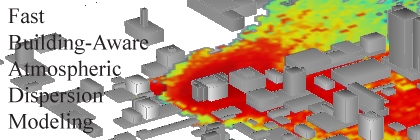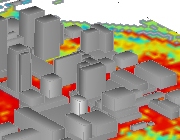
 Atmospheric Dispersion Modeling System
Atmospheric Dispersion Modeling System
LANL CONTACTMatthew Nelson |

QUIC-PLUMEQUIC-PLUME is a Lagrangian random-walk dispersion model for computing concentration fields around buildings. It has been adapted to work in the inhomogeneous environment of cities. It includes more terms than the normal random-walk model in order to account for the 3D gradients in turbulent and mean flow fields. It includes reflection terms for building and street surfaces. The dispersion of aerosols and gases can be simulated, including deposition, gravitational settling and health properties. Point, moving point, line, area, and volume sources can be simulated. An explosive buoyant rise and multi-particle size capability has been added for dealing with Radiological Dispersal Devices (RDD's). A dense gas cloud model has been incorporated in order to evaluate the effects of heavier-than-air chemical industrial gas dispersion. QUIC-PLUME also has the option of adding the effects of two-phase (vapor/droplet) thermodynamics on dense gas dispersion. There is also a model for UV agent decay which incorporates the effect of time of day, day of the year, geographic location of the release, and cloud cover. The model contains a simple outdoor-to-indoor infiltration parameterization that allows for calculation of indoor concentrations inside of single zone buildings. QUIC-PLUME can run in tens of seconds for smaller problems, but may take up to 30 minutes for large problems where a half million or more particles are to be released. The code has been tested for both idealized and real-world cases (e.g., Gowardhan et al., 2006; Williams et al., 2004). For more information on the specifics of the code, see the QUIC-PLUME Theory Guide. Capabilities
|

QUIC-PLUME ExamplesNear-surface X-Y plane of concentrations produced by QUIC-PLUME (x denotes the ground-level release point). |